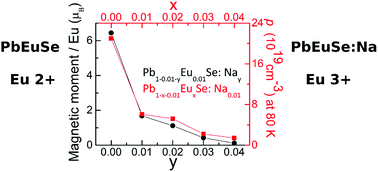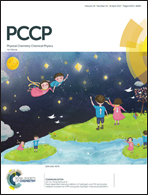Eu2+–Eu3+ valence transition in double, Eu-, and Na-doped PbSe from transport, magnetic, and electronic structure studies
Abstract
The Eu atoms in Pb1−xEuxSe have long been assumed to be divalent. We show that p-type doping of this magnetic semiconductor alloy with Na can modify the effective Eu valence: a mixed, Eu2+–Eu3+ state appears in Pb1−x−yEuxNaySe at particular values of y. Magnetization, carrier concentration, resistivity, and thermopower of Pb1−x−yEuxNaySe are reported for a number of samples with different x and y. A pronounced increase in thermopower at a given carrier concentration was identified and attributed to the presence of enhanced ionized impurity scattering. A strong decrease in the hole concentration is observed in Pb1−yNaySe when Eu is added to the system, which we attribute to a Eu2+–Eu3+ self-ionization process. This is evidenced by magnetization measurements, which reveal a significant reduction of the magnetic moment of Pb1−xEuxSe upon alloying with Na. Further, a deviation of magnetization from a purely paramagnetic state, described by a Brillouin function, identifies antiferromagnetic interactions between the nearest-neighbor Eu atoms: a value of Jex/kB = −0.35 K was found for the exchange coupling parameter. The conclusion of a Eu2+–Eu3+ self-ionization process being in effect is supported further by the electronic structure calculations, which show that an instability of the 4f7 configuration of the Eu2+ ion appears with Na doping. Schematically, it was found that the Eu 4f levels form states near enough to the Fermi energy that hole doping can lower the Fermi energy and trigger a reconfiguration of a 4f electronic shell.



 Please wait while we load your content...
Please wait while we load your content...